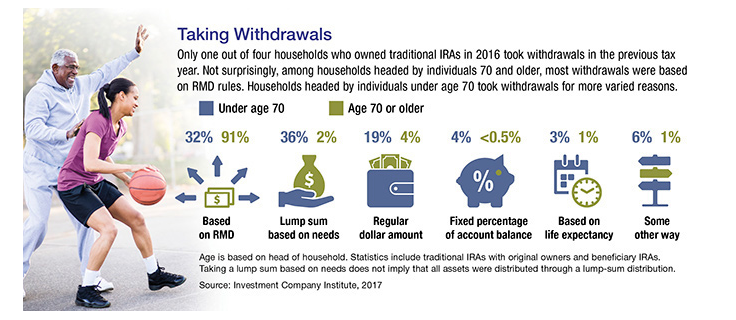7.26.18
Options for inherited IRAs

IRS rules for inheriting retirement accounts are complex, and an uninformed decision could result in unexpected taxes and penalties. Your options depend on your relationship to the original owner and the owner’s age at the time of death.
Beneficiaries of both traditional and Roth IRAs must take required minimum distributions (RMDs), with one exception for spouses (described below). If the original owner died after reaching age 70½ and did not take an RMD for the year of death, you may also have to take the owner’s RMD by the end of the calendar year.
Special Rules for Spouses
A surviving spouse can roll the inherited IRA assets to a new IRA in his or her own name. If the spouse is the sole beneficiary, the inherited IRA can simply be redesignated in the surviving spouse’s name (if allowed by the account trustee). Because the spouse becomes owner of the account, he or she can make additional contributions, name beneficiaries, and avoid RMDs from a Roth IRA. RMDs must be taken from a traditional IRA but don’t have to start until the surviving spouse reaches age 70½; they would be based on his or her life expectancy.
Options for Designated Beneficiaries
Nonspouse beneficiaries, as well as a spouse who does not treat an inherited IRA as his or her own, cannot contribute to the IRA and can only name “successor beneficiaries.” In most cases, the funds must be transferred directly (through a trustee-to-trustee transfer) to a properly titled beneficiary IRA; for example, “Joe Smith (deceased) for the benefit of Mary Smith (beneficiary).” All designated beneficiaries typically have four distribution options.
Life expectancy method. A “stretch IRA” typically involves taking RMDs over the life expectancy of the beneficiary. A nonspouse beneficiary generally must start taking distributions no later than December 31 of the year following the year of the IRA owner’s death. A spouse beneficiary may be able to delay payments until the year the IRA owner would have reached age 70½.
Five-year rule. If the original owner died before reaching age 70½, the beneficiary can satisfy RMD rules by withdrawing all assets — in one or multiple distributions — within the five-year period that ends on December 31 of the fifth year after the IRA owner’s death.
Lump-sum distribution. Regardless of the original owner’s age, the beneficiary can withdraw his or her entire share of the inherited IRA by December 31 of the year following the original owner’s death. This may be appropriate for small accounts, but you should think twice before liquidating a large account.
Disclaim the inherited funds. This may be appropriate if you do not need the funds and prefer that they pass to another beneficiary with greater needs or who would be subject to lower RMDs, allowing more time for the funds to grow. A qualified disclaimer statement must be completed within nine months of the IRA owner’s date of death.
Failure to take the appropriate RMD can result in a penalty equal to 50% of the amount that should have been withdrawn. Distributions from a traditional IRA are taxable as ordinary income. Distributions of Roth IRA contributions are not taxable, but the account must meet the appropriate five-year Roth holding period for tax-free distributions of earnings.
Distribution rules become more complex when multiple beneficiaries are designated and when the IRA is left to an estate or a trust. It would be wise to consult with a tax or estate planning professional before taking any specific action.
This information is not intended as tax, legal, investment, or retirement advice or recommendations, and it may not be relied on for the purpose of avoiding any federal tax penalties. You are encouraged to seek advice from an independent professional advisor. The content is derived from sources believed to be accurate. Neither the information presented nor any opinion expressed constitutes a solicitation for the purchase or sale of any security. This material was written and prepared by Broadridge Advisor Solutions. © 2018 Broadridge Investor Communication Solutions, Inc.
* Non-deposit investment products and services are offered through CUSO Financial Services, L.P. (“CFS”), a registered broker-dealer (Member FINRA/SIPC) and Registered Investment Advisor. Products offered through CFS: are not NCUA/NCUSIF or otherwise federally insured, are not guarantees or obligations of the credit union, and may involve investment risk including possible loss of principal. Investment Representatives are registered through CFS. Consumers Credit Union has contracted with CFS to make non-deposit investment products and services available to credit union members.


